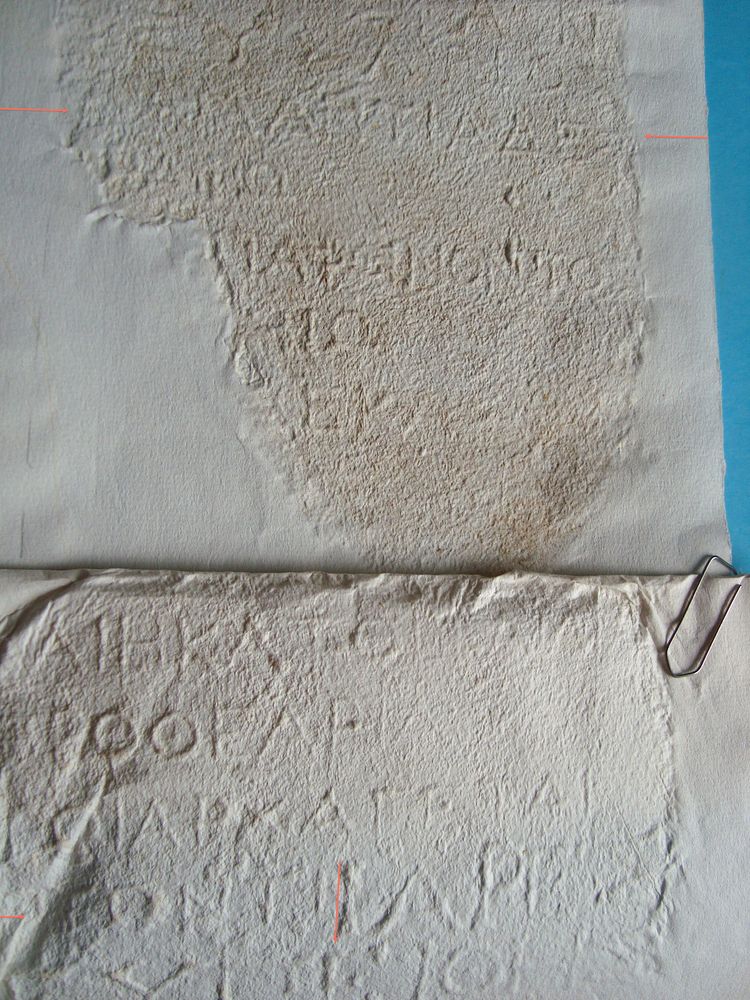EpiDoc XML:
IGCyr1092002
Trismegistos ID:
738621
Source description
Support: Large stele of white marble, broken in two pieces found separately, later re-used for IGCyr1093002; fragment a broken off at top and upper left edge and below, with a circular hole at 0.21 from bottom (w: 0.16 × h: 0.89 × d: 0.605); fragment b broken off above and at lower right angle, with edges better preserved than in fragment a (w: 0.16 × h: 0.63 × d: 0.65).
Layout: Inscribed in the middle of one narrow side, in 11 lines, beginning at 0.12 above bottom of fragment a and ending at 0.06 below top of fragment b.
Letters: 0.01 to 0.012, no serifs; dotted theta, slanting sigma, circular letters moderately smaller.
Date: First half of third century BC (lettering, material context).
Findspot: Fragment a: found not after 1960 at Cyrene ➚.Fragment b: found not after 1992 in a votive depot South of Cyrene ➚: in the area of Wadi el Aish.
Last recorded location: Cyrene Museum, 603 (fragm a), 850 (fragm. b). Observed in 1993 and again in 1997 and 2001 by C. Dobias-Lalou in Shahat: Cyrene Museum.
Text constituted from: Transcription from stone (CDL).
Bibliography
SECir, 114 and Mohamed – Reynolds – Dobias-Lalou 2007, pp. 30-34, n. 2 a, whence SEG, 57.2010, joined by Dobias-Lalou 2003, whence SEG, 53.2029 and again Dobias-Lalou – Dubois 2007, pp. 147-148, whence SEG, 57.2010; IGCyr 109200 ➚.
Cf. Brunel 1984, pp. 38-40, whence SEG, 34.1645; Pugliese Carratelli 1987, pp. 28-29, 32 (ph.), whence SEG, 37.1669 and 1670; Dobias-Lalou 1996, pp. 74-75, whence SEG, 46.2199; Dobias-Lalou 2000, p. 233; Rosamilia 2023, pp. 274-275, number 20 (text).
Text
Apparatus
2: Ἡ̣ραίω: [Ἡ]ραίω Brunel 1984; [.]ραίω SECir
3: [πέμ]π̣τα φθίνοντος: [πρ]άτα φθίνοντος Dobias-Lalou 1996; [κ]α̣ταφθίνοντος SECir
4: [Καρ]νήιω Dobias-Lalou 1996: [---]ηιω Pugliese Carratelli 1987 suggesting a month name; Δίω Brunel 1984; +ΙΩ SECir
5: [δυο]δ̣εκὰς: [...]δ̣εκὰς Dobias-Lalou 2003; δ̣εκὰς Brunel 1984; [---]+ΕΚΑΣ SECir
6: [Δί]ω̣ Dobias-Lalou 1996: [------] SECir
11: after this word and on the same line begins line 34 of side ii of IGCyr1093002
French translation
Jours d'Akamantia: le 26 Hèraios, le 12 Karneios, le [tantième] Dios et chaque fois que les trésoriers procèdent au sacrifice des prothearia pour l'Arkhègète.
English translation
Days of Akamantia: the 26th of Heraios, the 12th of Karneios, the [number]th of Dios and every time the treasurers offer the sacrifice of prothearia to the Archegetes.
Italian translation
Giorni degli Akamantia: il 26 Heraios, il 12 Karneios, il [tale giorno] di Dios e ogni volta che i tesorieri offrono il sacrificio dei prothearia all'Archegetes.
Commentary
The lettering as well as the display of side b of the stone (in IGCyr1093002) show that the latter resulted of a re-use. Why the former inscription was cut in the middle of the narrow side of the stele might be explained at least partly by the hole surmounting those few lines. The broader sides were perhaps not accessible for writing and/or reading if something was attached to the narrow side approximately at middle height.
We keep here the wider and traditional title 'sacred law'. In fact, this is more precisely a calendar of sacrifices.
The link between Ἀκαμαντιάδες and Ἀκαμάντια (IGCyr0167002, l. 21) was explained by Brunel 1984, approved by Pugliese Carratelli 1987.
Since both fragments have been brought together, some readings proposed before 2003 for the months and dates are no longer valid. What is now clear is that the name of the month at the genitive case was followed by the mention of the day inside it.
About the treasurers' role and the sacrifice called prothearia, see at Mohamed – Reynolds – Dobias-Lalou 2007, p. 32. We should add that IGCyr0641002, being a dedication by thearoi about to sail to Delphi, is probably related to that ceremony, which would logically have taken place at the port of Cyrene.
Additional comment for IGCyr2: the list of names cut on both sides of the stele later than those regulations has been identified by Rosamilia 2023 as priests plausibly of Ammon. The question now remains: what relation between Ammon's cult and the Akamantia? We know nearly nothing about the supposed sanctuary of Ammon were fragment b was discovered. The stele may have been brought from elsewhere on purpose of its re-use.
CC BY-NC-SA 4.0 Deed Attribution-NonCommercial-ShareAlike 4.0 International License.
All citation, reuse or distribution of this work must contain a link back to DOI: https://doi.org/10.60760/unibo/igcyrgvcyr2 and the filename (IGCyr000000 or GVCyr000), as well as the year of consultation.


